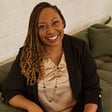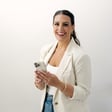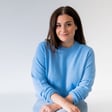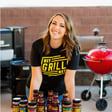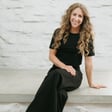The Role of Visuals in Branding
00:00:05
Speaker
So, stuff photography and graphics are actually a great way to maintain the integrity of your brand and also kind of continue your business to grow in that direction because you have visuals that pair with the copy.
Introduction to the Show and Host
00:00:23
Speaker
Welcome to The Brands That Book Show, where we help creative service-based businesses build their brands and find more clients. I'm your host, Davy Jones.
Meet Sarah K Love, Creative Consultant
00:00:35
Speaker
Today's guest is creative consultant, Sarah K Love. Sarah has taken her experience working for Nigel Barker in style and the not magazine to helping creatives visually market their business. Today we're chatting through what imagery to create for your business and how to go about creating that imagery.
Choosing Effective Imagery for Business
00:00:52
Speaker
We also chat about choosing images for your website
00:00:55
Speaker
and what can be done on an ongoing basis to help you stay organized. Be sure to check out the show notes at davianchrista.com for the resources we mentioned during the episode, and I'd like to hear from you about what kind of content you'd like to see on the Brands That Book podcast as we move forward. I'd also like to know what episodes you've enjoyed most so far and why. To leave your feedback, head on over to the Davian Christa Facebook page and send us a message. Now, onto the episode.
00:01:25
Speaker
All right, welcome to the Brands That Book podcast. I'm here with Sarah Love, who is a creative consultant, and I'm going to let her dive into all the things that she does here in a second. But first, welcome, Sarah. Thank you. I'm so excited to be here.
00:01:39
Speaker
We're excited to have you because just yesterday I was on a discovery call. We're talking about website design and branding. I got a question that is, it's become one of the most frequently asked questions during a discovery call and it's this. It's, do you all help pick the images that go into my website?
00:01:58
Speaker
And we do. That's something that we do. But that's also something that you do, that you can be hired to do. So I'm really excited to talk about how we can visually market our business with you effectively. Because I think for so many different people, even if they're photographers, it's hard to separate yourself from your work and figure out what goes where.
00:02:19
Speaker
So hopefully I think that's what we're going to be talking about during this episode.
Episode Aim and Visual Marketing Strategies
00:02:23
Speaker
So hopefully by the end of this episode, people will have a little bit more clarity about how to effectively visually market their business and more specifically, how to create content, visual content, and then where to share that visual content. So I'm excited to dig into that with you. Wonderful. Me too.
00:02:40
Speaker
Well, we start every episode just hearing about people's entrepreneurial journeys. We had a whole discussion about your title even before we jumped on this episode. But you're the first creative consultant. You're the first person who does what you do on this podcast. And it is very niche, I think, business that you have. So I'm excited to dig into how you got to where you are right now.
Sarah Love's Career Journey and Experience
00:03:05
Speaker
And just to give you a little bit of context for the kinds of things that Sarah does, she worked with Show It. So we had Todd Watson, the founder of Show It, on the podcast before. So if you listen to the podcast, you're probably familiar with Show It, but you helped put together the spark book for them. So you came in and helped consult on what kind of content should be in that book. What are some of the other things that you do?
00:03:26
Speaker
So I can help with content creation, which a lot of times within photographers and planners within the industry, they really just need help with getting styled editorials put together, a project manager coming up with some interesting ideas on how to create something that's unique and also how to photograph it. I help with publication and submissions, kind of diving in with photographers and planners of what images that will work best for submissions.
00:03:54
Speaker
and also curating images for your website and digital marketing strategies. And I got to imagine that you keep really busy because like I said, one of the single most frequent questions I get is, what images should I choose for this or that? So how did you get there though? So give us the backstory. You're in LA now. You were in New York. You have all sorts of incredible experiences under your belt. I want to hear about it.
00:04:18
Speaker
Okay, so it's one of those things where it's like, how did this all start? And like, can I go back to college? You know, but I think it really, it really did start there for me. I mean, I love, I've always loved photography and imagery and things like that and marketing as well. But I really started as a history and women's studies major. And I took a photography class in college because I needed an elective of all things.
00:04:41
Speaker
And that really spun into something where I started to see the world differently, but I didn't necessarily know if I wanted that to be a career. And after I graduated, I moved to New York without a job, of course, and not a ton of experience in photography at that point either. But I ended up getting a job with Nigel Barker of America's Next Top Model.
00:05:05
Speaker
as a studio manager. So I was really project managing all of his photo shoots and I really learned a lot about the production and commercial side of everything. And then from there I moved in style and then I ended up moving to The Knot and The Knot magazine. So how did you how did you land the job with Nigel Barker? I essentially showed up with a resume and asked and
00:05:31
Speaker
Really what ended up happening was like, I saw him and in like a coffee store and I was like, I really like you. You're awesome. I want to work for you. And he was like, Oh, that's so funny. But I ended up kind of getting that information, finding his information in one way or another. Again, I don't know how that's like public knowledge, but I ended up just asking and
00:05:55
Speaker
I think it was one of those things where he ended up needing someone to kind of come in and he had someone that had just gotten fired. And I came in and I said, I will do whatever you need. I'll start as your intern. I'll do, you know, pick up coffee, run errands, whatever you want. And then probably within a week, he was like, you're awesome. Come on board for my team. But yeah, that was kind of a long story short. It was very much serendipitous. And I got very lucky with that job.
00:06:22
Speaker
So after that, you moved over into I'm sure you learned a lot about publication just even working for Nigel Barker, but then you moved over into in style and eventually the not magazine. And about how long did you stay with in style and the not and what kinds of things were you doing?
00:06:37
Speaker
Yeah. So in style, I was working for the publisher. So I got to see a lot of the seals side of things, which was helped me kind of create a better understanding of what needs to go into sell a product for a magazine. And then I moved over to the knot magazine and I was there for about five years and I just left last November. So I've been out on my own for about a year.
00:07:02
Speaker
But I was at the knot. I did everything from shoe production for the fashion and still life covers to sourcing and curating real weddings for the magazine. So I did a lot on both ends. And from there, I kind of started to realize what images look good for, you know, from a photographer and from a planner standpoint of what's going to get published, as well as
00:07:25
Speaker
you know, learning how to, what we're going to talk about obviously today about how to make sure that image can sell a product or can sell a story properly. And yeah, I guess that was okay. Yeah.
00:07:38
Speaker
Yeah, and I think, I mean, just the kind of the education you got from your work experiences, probably drastically different than the education you got from school. Definitely. Yes, I think it's been within the last eight years I've learned so much. And then I kind of it's it started to realize that this was actually what I wanted to be doing in my passion.
The Impact of Imagery on Branding
00:07:57
Speaker
What kinds of things, especially while you're working with the knot and previously in style, what happened along the way to make you think, I should go off and do this on my own? There's a market for this kind of thing? Yeah, that's a really good question. I think it was one of those things where it definitely is a niche. I was a little hesitant just because you don't really have anyone else
00:08:23
Speaker
in the industry and when you're doing your elevator pitch and you're trying to kind of explain what you do, there isn't really anyone like it. But what I started to realize is when I left the knot, I mean, I was there for a really long time and I really gravitated towards our industry and everything that I was doing. And I was like, how can I put a spin on this? And when I left, I just had a huge flood of industry professionals start reaching out from photographers to planners.
00:08:49
Speaker
to you know anyone within our industry show it even and they really just started reaching out and saying can you help me curate this gallery for a wedding submission or can you give me an hour consultation on how to get published and what pictures I need to choose and
00:09:04
Speaker
Can you give me a site map for my website with images that will help, you know, lead to call to actions or social media planning? So from there I started to think, okay, wait, I think I might be able to do this. It's a little crazy, but this might actually, I think people, when they think of a brand, you really think about, you know, your brand voice and you think about the imagery and you think about the texts and the graphics and the fonts and the colors.
00:09:31
Speaker
But there's so much more to it that when you go to a website or you go to your social that you're like, you are automatically impacted by imagery more than we think. And so I think being able to share that knowledge and help people kind of start to understand that it's such a big part of their business was really important to me.
00:09:49
Speaker
Yeah, I think you just hear it about all the different things that you do. It's just so obvious there's a market for it. You know, I mean, like, you're the only person I know that does what you do specifically, right? But I just think it's so obvious, just based on the conversations I have with people on the struggle of figuring out, you know, I know all these images are beautiful, but what goes where and how do I go about sharing those things. And so it just makes so much sense to me that I mean, there's high demand for for what it is that you do.
00:10:18
Speaker
Thank you. Yeah, I'm really glad that you say that because I think it's been, obviously, even in the last year, it's been such a journey of taking that leap of faith and I'm coming also from working in corporate for eight years with big companies and you go into this smaller market and you end up working for yourself.
00:10:39
Speaker
as a small business owner, you know, we have all of these struggles that I think a lot of times within this podcast and within our community, you always hear people talk about. And it's been so amazing to be able to have people like you and everyone in the industry that kind of has those same feelings about it because, you know, you're, you don't think you're okay. I can do this type of thing.
00:11:00
Speaker
Yeah, I think probably, I mean, I'm not sure, but if you feel sometimes like the stuff that you do is so ordinary to you, right? But to everybody else, it's pretty extraordinary. And so I think especially as a small business owner, it's easy to forget that just because we live in what we do. And so that kind of stuff is just like, oh, you know, you kind of forget like other people really need help with these kinds of things, whatever it may be that you do.
Understanding Brand Identity and Visual Consistency
00:11:26
Speaker
So anyways, we're going to dive into it and we're going to start at the very beginning. So chatting about visual marketing here, specifically choosing images for platforms like your website, where would we start if we don't have any imagery? So I think it was one of, it was interesting of something that you said at the very beginning, which was, you know, what goes into choosing an image, but then from there, what if we don't even have photos?
00:11:52
Speaker
So I think that's also a big part of it. So depending on who's listening, if you're a photographer or if you're a planner or, and Davey, I don't, if there are potentially other people, you know, that I should be, I don't want to just, I guess I should also say, I don't want to like put this right into the wedding industry. If I need to kind of branch out a little bit, let me know.
00:12:12
Speaker
Oh, no, you're good. Yeah. Okay. Okay. So first and foremost, I would say that you need your brand. You have to understand your brand and what you visually want to show and what emotionally you want to portray to your audience. So we kind of
00:12:27
Speaker
we kind of call this finding your brand voice. So from there, once you kind of understand to your audiences and what you want to portray and the emotions that you want to evoke when we look at an image, from there, there are a few different places that you can start. But you want to make sure that within this process, that every image that you choose, it's going to point in the same direction as your overall brand message.
00:12:51
Speaker
And you can start with a style guide. Even before imagery, I think there's a big part of planning that would go into this, especially if you're going to do something like content creation or even stock photography. It's just starting with a style guide. And a lot of times if you work with a graphic designer or you're working with someone that's building your website, it's really finding the brand personality. So your brand voice, your color palette, your font, your graphics, your logo, what's your vibe?
00:13:20
Speaker
And then this will make that image creation and the curation a much smoother process because you'll know what you want and you can really remain consistent. I really appreciate that you start there. We talk to a lot of people who are just getting started in business. And a lot of times people know, oh, well, I'm starting a business, I need a website. And they skip right over the branding portion of that. And we always say, well, are you sure you don't want to start with brand design?
00:13:49
Speaker
or people who are trying to weigh between website design and brand design and they think maybe within the next year they're going to do some sort of brand or rebrand. We always say, hey, start with the branding project because that's going to help speak into the website design that you do. And then in this case and talking about just visual marketing in general, all the other visuals that you're going to put together for your business.
00:14:10
Speaker
So we always tell people start there. And when you work with a brand designer, you're going to walk away with a style guide. You're going to walk away with a pretty thorough brand style guide that's going to influence the rest of your business. Yes.
Producing Unique Content through Styled Shoots
00:14:22
Speaker
And it will make that implementation so much easier.
00:14:27
Speaker
And it was, it's, it's also, you know, when some of the photographers, you know, ask me, okay, well, is I want to use this image. This is the image that I want to use. You have to think, okay, is this part of your brand? Is this what you're trying to sell as a product and as yourself? And I think that a lot of times within the clients that I work with, it's, it's really trying to figure out, you know, why is this image special? Because they have attachment.
00:14:53
Speaker
emotionally to an image that like as a photographer, this is the photo of a couple kissing and it was right at the last second, right before it started to rain and it's beautiful and everything in this moment I wanna showcase and capture and have my audience view. But the image is blurry and the lighting is poor and it's not gonna work. It's a vertical image and you need it for a hero horizontal shot of your website. It's not the right photo and you have to kind of take
00:15:22
Speaker
a step away as well when for something when I'm kind of curating images is you have to be able to also emotionally remove yourself from that to make sure that it's still going to fit right with your brand. You know if this was like a digital photo that had to be taken because it was raining and it was very dark if you're if they're normally a film photographer you're might not going to want to showcase that.
00:15:46
Speaker
Sure, sure. So where would somebody even start though in creating that content? What are some of the things that they could do?
00:15:53
Speaker
So I would say start with hiring a photographer. And if you're not a photographer, I would potentially start by hiring one. And you can do styled editorials. A lot of times, you can either create your own. You can hire someone to produce it. You can go to a workshop and conferences that also have style editorials. That content is going to be there for you to have, to photograph, or to have someone else photograph for you.
00:16:21
Speaker
Unfortunately, with this, sometimes you're going to have the same content as other people. So sometimes it's potentially, I would say, creating editorials yourself that are going to be unique to you.
00:16:38
Speaker
I would start with potentially video and head shots. You know, I think the easiest place to is really to start with the picture of yourself. You know, I mean, if it's just, if you're going to start with your website or within your social, having those head shots is a great place to say like, Hey, come to my website. This is who I am. This is what I do. I want people to know my voice. I want to know a little, they want to know behind the brand. And so they also have that element of relatability.
00:17:04
Speaker
And would you say that there's value in working with somebody who could produce a style shoot like yourself? I know that in the past, especially when we were putting together style shoots, when we were just starting out, that we would always try to work with at least a planner, you know, that would, that had the eye to produce, you know, an event that maybe otherwise we wouldn't be able to put together on our own. Yeah, definitely. I think for something, and you know what, for me, what I'm doing is, you know, I have my background is in the production
00:17:33
Speaker
side of things. So producing a style to, you know, is something that I love to do for clients as well. But a lot of times what I've ended up finding is that it actually really helps for me to work with a planner as well, because I come in and I can say, all right, listen, I'm going to come in and I'm going to try and help get these images for your brand, for your website, and how you're going to use them. What's the creative strategy that we're going to use for each of these photos for your digital marketing platform? I want to make sure that you have images
00:18:02
Speaker
specifically for your brand and a planner can come in and say, I want to have.
00:18:08
Speaker
How I'm going to produce this is pretty. I'm going to come in with all of the awesome creative ideas and all of the incredible rentals and flowers and theme and story and color line. And I'm going to be able to create that. And we kind of work together in a sense of I'm going to try and figure out how to get that direction of making sure that the photographer or the planner or whoever is creating this content has everything that they need specifically tailored to them.
00:18:36
Speaker
And the planner is going to make sure that it turns out beautifully and we work together. Sure. So before we move on to talking about what kind of imagery somebody needs to create, do you have any tips for producing that imagery maybe so that it stays consistent or I guess just on the production side and actually when you organize that style sheet or whatever it is, do you have any tips for production? I have a lot.
00:19:04
Speaker
I think there are so many things. What I can say for the most part is I would say it's an investment. We have talked quite a bit about the pros and cons of producing a styled shoot.
00:19:18
Speaker
But I think one of the main things that I can say is, you know, it's going to be an investment. And so when you do this, you need to make sure that you come in with that strategy. It's not just, I want, is it, do you want to get published? Is that your goal or is it to create content for your site?
00:19:35
Speaker
Have a site map ready. You know, be working with a website designer, having have a flow of what you know you want your pages to look like. So if you need a picture of, you know, a microphone on a desk because you're going to have a podcast for a specific podcast page, or is it a picture
00:19:54
Speaker
of you in your office with your dogs that you want on your contact page or is it you working for your services page or is it a separate site for just all of the products that you're going to be selling. What is it and how many images do you need because that will make it go so much faster and it will be planned out with a strategy rather than showing up at the shoot and just
00:20:18
Speaker
hoping that you're gonna get everything that you need and then potentially when you go in to implement these images, they might not be.
00:20:25
Speaker
everything, you might fall short. It's not only an investment sometimes monetarily, but certainly in time. Going into something like that, I just think that there's such value in hiring somebody to do the production of it so that you can focus on actually taking the photos or getting the photos that you need if you're not a photographer and you're using something like a style shoot to get images. I
Balancing Custom and Stock Photography
00:20:51
Speaker
guess I can't overstate that enough.
00:20:53
Speaker
So moving on, what kind of imagery does someone need to effectively market their business? So if we were to schedule this photo shoot for our brand, what images should we seek to create? Okay, so I did want to just, you know, obviously we have the content creation side of things.
00:21:09
Speaker
But I also think it's super important to also state that their stock photography, there is definitely a value in it. I think a lot of times, you know, you want to share your business. You want to talk about inspiration. It could be trends. It could be graphics. It could be something that you don't have in your portfolio or you might not have the budget at this time to do a styled shoot or go to a conference that has
00:21:31
Speaker
you know, those style shoots for you. So staff photography and graphics are actually a great way to maintain the integrity of your brand and also kind of continue your business to grow in that direction because you have visuals that pair with the copy and with your expertise. So, you know, stock photography companies, you know, Shutterstock, Stocksy, Getty images, creative market has them. And then source code is also awesome. They're brand new.
00:21:58
Speaker
and they are specifically for creative and wedding professionals. So I think that this is also something where if you're just starting out and you potentially don't know where to begin, that stock photography is also really a great way to do it.
00:22:13
Speaker
And you can generally, not always, especially some of the nicer stock photography can get a little bit of expensive. But I would say that it's a little bit less of an investment than putting your own production together. Yes. If it's five different images, or I would probably say five to 10 photos. But again, mixing and matching your content and
00:22:36
Speaker
custom content with stock photography is a great way to do it. But again, if you're just starting out and you're really at a standstill for the time being, incorporating those in is a great way to be able to help your brand still stay on, have its integrity. Sure. Awesome. So moving on to the kinds of imagery that you want to create if you were to organize something like a style shoot. Yes.
00:23:03
Speaker
For every business, it's different. And we kind of start by asking, what is your business? What are you trying to sell? But once we kind of figure out those images, you're then able to promote your brand. So with these images, you're able to use them for your website and social media accounts. You're able to use them for digital marketing. You're able to use them for your marketing materials. Is it your website? Is it a brochure? Business card? Is it, you know, eBooks, guides, newsletters?
00:23:31
Speaker
And even, you know, when then it comes to the websites. It's landing pages hero images for your homepage or header images for blog posts services about me pages and you can even use them for backgrounds. And I think
00:23:48
Speaker
When you're also getting into creating images, you can keep in mind too that it doesn't necessarily have to be just photos. It can be graphics. It can be infographics. It can be illustrations. It can be patterns that you can weave them all in together.
00:24:03
Speaker
And so I'm guessing kind of the underlying message here is, I guess it emphasizes how important it is to plan this kind of stuff ahead of time. Because, you know, you just went through a list of things. And I could see somebody putting together this style shoot, not really knowing that they need imagery for all these different things, but then actually doing the style shoot or putting together some sort of brand shoot and not actually getting the images they need for any of these things, or maybe only for a few of these things.
00:24:32
Speaker
Yes. And I think it's, you know, when you're planning it out in that sense, you can say, okay, I know that I'm going to need an opening image for my website. That is the best representation of my work that I want to have to be the most impactful. I want to make sure I get that one photo, but I also want to make sure if I'm using it for marketing materials or any advertising materials that I can have maybe the same shot or a different shot, but with some white
00:24:58
Speaker
background on the side. So there's room for text so I can put my text over it, or I can have another image because I really like to do inspirational quotes on my Instagram that I can have an image that will allow me to put an overlay and text on top of that. So working those in as well. And that can be so simple. It just making sure to have that in your shot list.
00:25:23
Speaker
That can just be something as simple as taking a picture of a bouquet and then moving it to an angle and taking it on the side and making sure there's just a little room on the side for all of those other ideas that you have. So it could be something that simple when you're coming in and being able to do that.
Optimizing Image Placement and Orientation
00:25:41
Speaker
Sure. So moving from the shoot to actually sitting down and taking those images that you've created, or that you've hired somebody to create, like what steps exactly would you take to help someone choose images for their website? And something you touched on the beginning, which I think is just really important. I love the fact that you focus on this, you know, how do you balance making sure that there's, you know, pretty imagery, like
00:26:06
Speaker
especially within our industry, everything is so visually focused that we want to make sure that things look good. For sure, that is important. But we also want to make sure that our website does its job in converting people into clients or customers. So how do you balance those two things?
00:26:24
Speaker
That's a great question. So I think it can go in a few different directions, but first and foremost, it really is almost like a site map of images. So you know which images that you need and it's going to help. But I think the other part of it is when I look at an image, most of the time I start with clients and I say, I'm going to go to your website. It's a homepage. What am I looking at? Is this the best photo?
00:26:53
Speaker
that you have ever taken or that will ever represent you. And it's a big question. They're like, Oh my gosh, I don't know about that. It's a sliding gallery. It's like, Oh, these are the three best photos I've ever taken. I don't know. But I think when you're able to answer that you're able to go to your site and you're no people, you know, that you have a site that you believe in that people are going to say, this is my best work.
00:27:16
Speaker
This is what people are going to get excited about because I'm excited about it and I want to share with them. You know what gives me my inspiration and I want to have that moment that makes a big impression. So I start there by making that big impression and from there it's really more along the lines of you know blog and image pairings and.
00:27:39
Speaker
You know, with editing styles, I make sure that I'm looking at the editing style. Are they a film photographer or a digital photographer? Are they using the same, you know, styling or preset? So everything in the same light. So it all remains consistent. And I think the other part that I do with clients that it's, I probably will, I might've emailed this to you, but I'm not sure is I take a screenshot.
00:28:05
Speaker
and I write over the images. I draw all over them. And I think a lot, and that sounds very confusing, but let's say that it's four images of a wedding photographer site, and it's the four different galleries. One's an engagement, one's family, one's professional, and one's weddings, and maybe one's travel. And every single one of them are up close headshots of a couple.
00:28:30
Speaker
or it's, you know, of their hands or their feet or something. And I look at them and I say, okay, this is all the same image and I'm kind of bored. And there's something that unless you have a different eye or a different perspective to be able to say, okay, let's make sure that one's pulled back and one's close up and, you know, making sure that they coincide next to each other, that the colors all, all balance out as well.
00:28:55
Speaker
I think that that's something where, when you're showcasing these galleries, you want to make sure that it all seems cohesive. And I think the other part of it is, is that a lot of times people forget about landscape oriented photos, you know I know myself included. we're so used to taking vertical because you're on your phone or your camera and that's just like the go to.
00:29:16
Speaker
But I think the portrait orientation can really get overlooked and it's a really great way to make sure that when you shoot with this, when you're shooting on landscape, there's going to be so many different avenues for you to use those images as well. And I think it's great for them to be able to throw them into the mix.
00:29:35
Speaker
Yeah, so I was thinking about two things as you're talking one, you know, as far as having on the homepage, the very first image someone sees the best image that that you've ever taken, you know, I think that's such a powerful question to ask people. I think oftentimes we get stuck, or we think that variety is what people want.
00:29:52
Speaker
Well, I want to show that I can shoot this way too. And I think largely that, and I don't know if you would agree with this, but largely that variety is often overrated. And the homepage of your website, probably not the place where you want to show people that you can do certain things, you really should, like you said, include those images that people are going to get really excited about because you're going to get really excited about.
00:30:15
Speaker
And then the second thing that I was thinking about was how we encourage people to organize the galleries on their website. Generally, on a weddings page for a website, instead of having a galleries page where you have weddings, families, engagements, or whatever, we often tell people to include galleries of events or couples. And of course, that's going to differ based on what kind of
00:30:37
Speaker
you know, industry you're in, whether you're a photographer or not a photographer, but we work with a lot of photographers on their websites. And so what we'll say is, you know, include galleries, but include galleries of events. And that way, the images within those galleries look more cohesive than just, you know, 10 different weddings
00:30:55
Speaker
thrown into the same weddings gallery. Because even if you have the same style, those weddings might have some different aesthetics. So we find it's maybe a more effective way to highlight your work so that things look a little bit more cohesive. Yeah. And I like that point too, because even though you're photographing all weddings, all the weddings might have a different look. And so that can give you that variety.
00:31:22
Speaker
Yeah, exactly. For instance, on a wedding's page, if you're a wedding photographer but you also do families, let's say you have a wedding's page on your website, we'd encourage people to have six to nine galleries on that page. But instead of just having one gallery of a bunch of weddings together, so it'd be like
00:31:42
Speaker
Karen and Joe would be a gallery and then you'd click into it and you'd find 20 of your best images from that day that very loosely tell the story of the day. And it's a way to show, you can show kind of, it's like a mini blog post almost, but without sending people off to a blog page.
00:31:59
Speaker
But in general, appreciate what you're saying about, especially in that hero image, having a picture that is, is it the best picture that you've ever taken? And if not,
Collaborative Image Organization and Tools
00:32:09
Speaker
why is it there? So as we talk about choosing images for your website specifically, how do you go about creating that site map? Is that something that you coordinate with the designer on? Or is that something that you outline with the client? What does that process generally look like? The process is definitely a lot of times I ended up working with a web designer.
00:32:29
Speaker
And the client, so all three of us just because I think, you know, normally the photographer or the planner has a specific vision of what they want their site to look like. And when that is implemented, I'm able to say, okay, look at we're going to have, you know, sometimes is it a banner ad or there are four images that you want to showcase for a gallery? Is your gallery even going to be on the homepage?
00:32:51
Speaker
Or your service is going to be on the home page, or is there going to be an image next to services? So figuring out the different how many images on each from there will help us kind of guide in the general direction.
00:33:04
Speaker
I'm just thinking to myself like how I'm sure that the designers that you work with really appreciate this too. You know, because I know that there is a lot of education that goes into, I mean, just speaking from experience, giving clients direction on what kind of images, you know, should go where and why. So I'm sure designers really appreciate your input. And it was funny because when I was first designing my own website, you know, part of it was a lot of the times the web designer will just
00:33:31
Speaker
put in images as placeholders, and then you go in and switch them out for a decent chunk of designers will design the website. And then they'll have, you know, we call them placeholders. And then you're stuck to your own devices being like, Oh my gosh, I now have an infinite amount of images on my Dropbox of thousands of photos and like, which one's going to work best? I don't know where to even begin. And that in itself can be almost overwhelming as well.
00:33:59
Speaker
Yeah, absolutely. Absolutely. I just think having an outside perspective, somebody who's outside your own work and hasn't been staring at it as much as you could be helpful, but certainly somebody with your background in production and working with all these different publications would be super valuable as well. On an ongoing basis, what are some of the ways that people should be consistently marketing their business on a visual level? I think
00:34:26
Speaker
This is probably the longest answer and there's definitely a few different things that I want to tackle here. But, you know, even though this is so generic with what I'm about to say, you know, I think when we're looking for new ways to continue to consistently market our brand and our business, just find new ways of inspiration. And I know, I know, I know, I know.
00:34:49
Speaker
When we're finding new ways to incorporate imagery and keeping things fresh and we're keeping, you know, we're, we're staying inspired. That's just going to give new ideas. And so I think the first way to do that is to really start with inspiration. And then, you know, from there, when you start to have these images, you know, start to showcase these visuals in a different way.
00:35:12
Speaker
each time on social media platforms. So depending on what that image is, find multiple ways to use it and start also by, you know, figuring out your content management system. Is that Dropbox? Is it, you know, there are certain galleries or is that Later or Planoly or the social media strategy and, you know, that management system for social management and
00:35:42
Speaker
Once you start to kind of have that content management system, you're able to then start organizing, you know, the strongest brand images that you have, the patterns, the graphics, the infographics, you're able to keep them organized and by categories and say like, this is a photo that will work well for with white space for ads. And this will work great for blog posts with headers. This is great for a newsletter.
00:36:08
Speaker
And when they're organized, then you can kind of go into these folders and say, OK, I'm running really low on images that I want to put for my blog posts or my blog headers or my banner ad. And so I can say, OK, I'm going to need to do a separate shoot or I'm going to create new content for this specifically.
00:36:32
Speaker
So I know it's going to vary across, depending on what you do and depending on the kind of imagery that you're going to use. I know that we personally, we use later for Instagram, we use Tailwind for Pinterest. What content management systems, as you put it, do you recommend to organize your imagery?
00:36:49
Speaker
So again, I think Tailwind's great later. Planoly is also awesome. Dash Hudson, Dropbox is great too. You know, I think you can also, you know, Lightroom and Bridge also have some awesome options too when it comes to doing that. A lot of times I end up just working off of Dropbox, but I know some people really like working off Pass as well.
00:37:11
Speaker
So I think that pushing out their galleries and things like that, sometimes they want to keep it organized in that way. But a lot of times I find that Dropbox is the easiest way to work off your desktops, share with others online, always have it available. So those were probably where I would start recommending.
00:37:30
Speaker
Yeah, and a lot of those we use in our business as well, and just really appreciate them based on how easy they're used. For photography, we use CloudSpot, really like CloudSpot because there's not a limit to, at least on the plan we're on, there's not a limit to how many galleries that you can create, which is helpful for being able to get specific about creating galleries for different things, whether it be our social channels or a website or whatever it might be. And then later, like I said, for Instagram,
00:37:58
Speaker
They have a sweet auto posting feature now, which I think it's probably pretty standard now for similar tools, but later makes things easy on the Instagram front.
00:38:09
Speaker
We really appreciate your time today.
Closing Remarks and Contact Information
00:38:12
Speaker
Like I said, one of the hardest things I think for people to do is picking out the images or even thinking through what images they need to market their business. There's no way that even in the 50 minutes that we've talked that we could possibly cover all of that. People who want to follow along and learn more about you and what it is that you do, where can they find you? Definitely. They can find me on Instagram, which is
00:38:38
Speaker
Sarah K. Love, K-A-Y-L-O-V-E, and online as well, sarahklove.com. Awesome. Well, thank you so much for your time today, Sarah. Thank you so much. I'm so happy that I was able to come on. Yeah, us too. Thanks for tuning in to the Brands That Book Show. If you enjoyed this episode, please consider subscribing and leaving a review in iTunes. For show notes and other resources, head on over to devianchrista.com.


